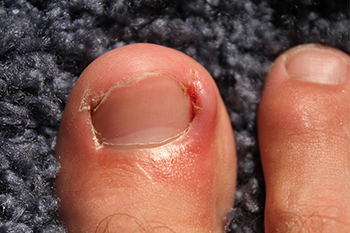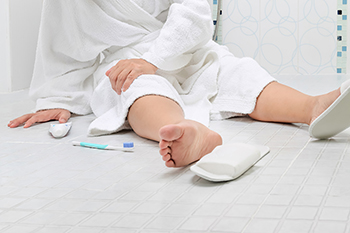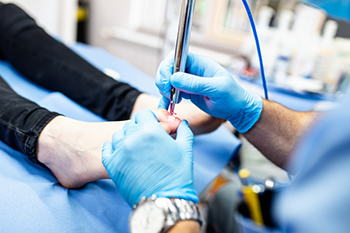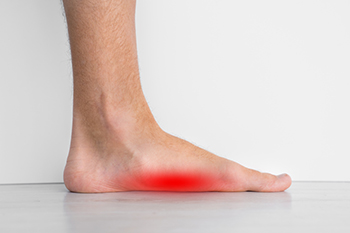Connect With Us
Blog
Items filtered by date: November 2023
Ingrown Toenails and Infection Control

Ingrown toenails, a common condition where the nail grows into the toe's skin, can lead to infections if not properly managed. They most often affect the big toe and can result from trauma, improper nail trimming, and wearing tight footwear. The skin surrounding the ingrown nail becomes red, swollen, and painful, and may produce pus, indicating an infection. Preventing infection in ingrown toenails involves proper foot hygiene and nail care. Toenails should be cut straight across, avoiding rounding the corners which can encourage the nail to grow into the skin. Wearing properly fitting shoes that provide enough space for the toes to wiggle freely in can also reduce the risk. If you have an ingrown toenail and suspect an infection, it is strongly suggested that you make an appointment with a podiatrist for an evaluation and treatment.
Ingrown toenails can become painful if they are not treated properly. For more information about ingrown toenails, contact Dr. Howard Horowitz of Bowie Foot & Ankle . Our doctor can provide the care you need to keep you pain-free and on your feet.
Ingrown Toenails
Ingrown toenails occur when a toenail grows sideways into the bed of the nail, causing pain, swelling, and possibly infection.
Causes
- Bacterial infections
- Improper nail cutting such as cutting it too short or not straight across
- Trauma to the toe, such as stubbing, which causes the nail to grow back irregularly
- Ill-fitting shoes that bunch the toes too close together
- Genetic predisposition
Prevention
Because ingrown toenails are not something found outside of shoe-wearing cultures, going barefoot as often as possible will decrease the likeliness of developing ingrown toenails. Wearing proper fitting shoes and using proper cutting techniques will also help decrease your risk of developing ingrown toenails.
Treatment
Ingrown toenails are a very treatable foot condition. In minor cases, soaking the affected area in salt or antibacterial soaps will not only help with the ingrown nail itself, but also help prevent any infections from occurring. In more severe cases, surgery is an option. In either case, speaking to your podiatrist about this condition will help you get a better understanding of specific treatment options that are right for you.
If you have any questions please feel free to contact our office located in Bowie, MD . We offer the newest diagnostic and treatment technologies for all your foot and ankle needs.
Effective Fall Prevention Strategies for the Home

Preventing falls at home is essential for maintaining safety, especially for seniors or those with mobility challenges. You can take several steps to create a safer living environment. Begin by evaluating your home for potential hazards, paying close attention to loose rugs, clutter, and uneven surfaces. Ensure that walkways are clear, and keep frequently used items within easy reach. It is helpful to install handrails and grab bars in critical areas such as bathrooms and staircases that can provide essential support. Having adequate lighting is important so make sure that rooms and hallways are well-lit, with light switches easily accessible. Consider using non-slip mats in the bathroom and kitchen to reduce the risk of slipping. Furniture arrangement also plays a role, and it is beneficial to have it arranged in a style that can create clear pathways and ensure stability. Wearing supportive footwear with non-slip soles is essential, as it can greatly reduce the risk of falls. Additionally, staying physically active and maintaining muscle strength can improve balance and coordination, making falls less likely. Falling can greatly impact the feet, and it is suggested that you visit a podiatrist who can help you implement successful fall prevention strategies.
Preventing falls among the elderly is very important. If you are older and have fallen or fear that you are prone to falling, consult with Dr. Howard Horowitz from Bowie Foot & Ankle . Our doctor will assess your condition and provide you with quality advice and care.
Every 11 seconds, an elderly American is being treated in an emergency room for a fall related injury. Falls are the leading cause of head and hip injuries for those 65 and older. Due to decreases in strength, balance, senses, and lack of awareness, elderly persons are very susceptible to falling. Thankfully, there are a number of things older persons can do to prevent falls.
How to Prevent Falls
Some effective methods that older persons can do to prevent falls include:
- Enrolling in strength and balance exercise program to increase balance and strength
- Periodically having your sight and hearing checked
- Discuss any medications you have with a doctor to see if it increases the risk of falling
- Clearing the house of falling hazards and installing devices like grab bars and railings
- Utilizing a walker or cane
- Wearing shoes that provide good support and cushioning
- Talking to family members about falling and increasing awareness
Falling can be a traumatic and embarrassing experience for elderly persons; this can make them less willing to leave the house, and less willing to talk to someone about their fears of falling. Doing such things, however, will increase the likelihood of tripping or losing one’s balance. Knowing the causes of falling and how to prevent them is the best way to mitigate the risk of serious injury.
If you have any questions, please feel free to contact our office located in Bowie, MD . We offer the newest diagnostic and treatment technologies for all your foot care needs.
Who Benefits From Laser Treatment for Fungal Toenails?

Laser therapy uses focused light to destroy toenail fungus, preventing it from spreading or getting worse. This type of treatment has evolved since the 1980s with various lasers now in use, affecting the success rate for different individuals. Laser treatment can be particularly useful for individuals who cannot take certain medications due to liver or kidney problems, in addition to people with diabetes, and older adults who might not tolerate drugs well. Early treatment of toenail fungus is advised by the CDC to stop the spread of the infection and ensure better results. If not treated, the fungus may spread beyond the toenails. If you have toenail fungus, particularly if it does not resolve with more conservative treatment, it is suggested that you make an appointment with a podiatrist to discuss whether laser treatment may be an option worth considering.
Laser treatment can be an effective way to get rid of toenail fungus. If you have any questions about laser treatment, consult with Dr. Howard Horowitz from Bowie Foot & Ankle . Our doctor will assess your condition and provide you with quality treatment for fungal nails.
What Are Toenail Fungal Infections?
Onychomycosis, or fungal infection of the nail, is a relatively common and non-serious condition. Around 10 percent of U.S. citizens are afflicted with fungal nails. Common forms of fungus that infect the nail include dermatophytes, yeasts, and molds.
Symptoms of Toenail Fungal Infections Include:
- Nail thickening
- Brittleness of the nail
- Discoloration of the nail
Diagnosis for Fungal Nails
Fungal infections are diagnosed by fungal culture and microscopy. This will rule out any other conditions such as nail trauma, psoriasis, lichen planus, and onychogryphosis.
What Is Laser Treatment?
Laser treatment is a non-invasive, safe, quick, and painless procedure that uses the heat from a laser to kill fungus in the nail. Each infected nail is targeted with a laser for several minutes. The treatment is usually utilized several different times over a select period. During this time, a podiatrist will keep an eye on the infection.
If you have any questions, please feel free to contact our office located in Bowie, MD . We offer the newest diagnostic and treatment technologies for all your foot care needs.
Symptoms and Causes of Flat Feet

Flat feet, also known as fallen arches, is a common condition where one or both feet lack the typical arch structure. Instead, the bottom of the foot lies flat on the ground. While babies are initially born with flat feet, their arches generally begin to develop by the age of two or three. However, some people may continue to have flat feet into adulthood. In older children, common symptoms of flat feet include foot or ankle pain, heel or arch pain, and discomfort during walking and running. Adults with flat feet may experience symptoms such as tired or achy feet after prolonged standing, sports activities, or exercise. Many also experience lower back, hip, and knee pain. In children, many cases are attributed to what is called flexible flat feet, a result of loose joint connections and baby fat between the foot bones. This can cause the arch to collapse when the child stands. In adults, flat feet can be linked to factors like weakened or torn tendons, rheumatoid arthritis, midfoot fractures, or ligament injuries. Recognizing the signs and understanding the underlying causes of flat feet is essential for proper management and treatment. If you believe that flat feet are causing health and mobility problems for you or your child, it is suggested that you make an appointment with a podiatrist for an exam, a gait assessment, and appropriate treatment options.
Flatfoot is a condition many people suffer from. If you have flat feet, contact Dr. Howard Horowitz from Bowie Foot & Ankle . Our doctor will treat your foot and ankle needs.
What Are Flat Feet?
Flatfoot is a condition in which the arch of the foot is depressed and the sole of the foot is almost completely in contact with the ground. About 20-30% of the population generally has flat feet because their arches never formed during growth.
Conditions & Problems:
Having flat feet makes it difficult to run or walk because of the stress placed on the ankles.
Alignment – The general alignment of your legs can be disrupted, because the ankles move inward which can cause major discomfort.
Knees – If you have complications with your knees, flat feet can be a contributor to arthritis in that area.
Symptoms
- Pain around the heel or arch area
- Trouble standing on the tip toe
- Swelling around the inside of the ankle
- Flat look to one or both feet
- Having your shoes feel uneven when worn
Treatment
If you are experiencing pain and stress on the foot you may weaken the posterior tibial tendon, which runs around the inside of the ankle.
If you have any questions please feel free to contact our office located in Bowie, MD . We offer the newest diagnostic and treatment technologies for all your foot and ankle needs.

